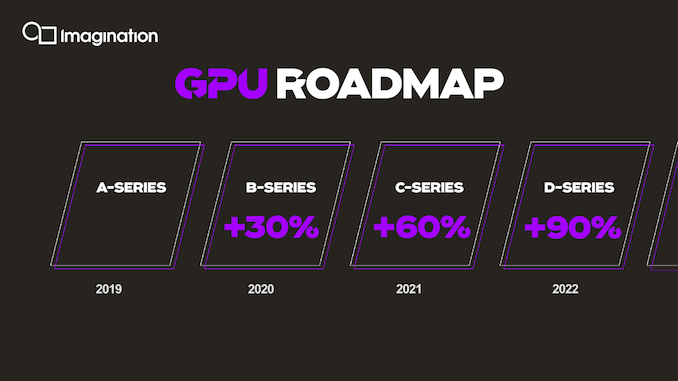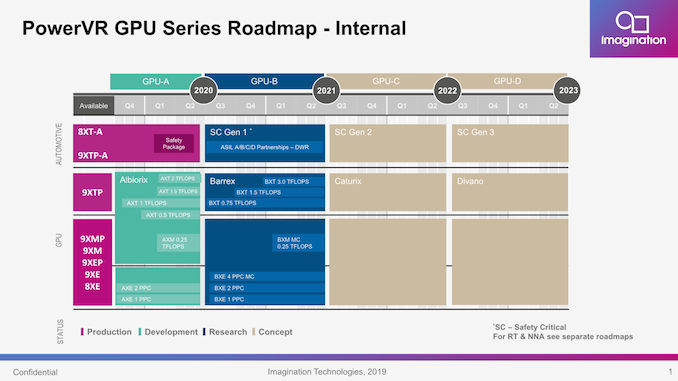Imagination Announces A-Series GPU Architecture: "Most Important Launch in 15 Years"
by Andrei Frumusanu on December 2, 2019 8:00 PM ESTFuture Roadmap & Final Thoughts
The new A-Series architecture means to represent a reset for Imagination’s product offerings, representing a bright new future for the company. The new GPU IP is certainly impressive in terms of the PPA metrics that it promises to achieve, and if realized, it does have ramifications for the wider industry and the competitive landscape.
But even if the A-series can deliver on all of Imagination's promises, the company can't stop there. The competition is continuing to refine and improve their designs, and so must Imagination. To that end, along with today's announcement of the A-series, Imagination is also publishing a very broad roadmap for the next few years, outlining the upcoming GPU generations and their expected performance gains. All of this is especially important for SoC designers, who want to know what's coming down the pipe before making the effort to switch IP vendors.
Imagination’s roadmap following the A-Series is seemingly very aggressive, promising yearly updates going forward, with large annual performance increases of 1.3x, or a 30% yearly compound annual growth rate. This is a much bigger goal than we’re used to historically, but it’s very much in line with the pace of progress we’ve seen from some vendors in the past, or even what Apple has managed to recently achieve over the last two generations.
For the A-Series, Imagination has adopted a public announcement schedule more similar to Arm’s, meaning that the A-Series has already been finished and licensed out to customers, with SoCs being designed and prepared to hit the market for 2020 – we’re assuming the latter part of 2020.
The B-Series is already well under way in terms of development and projected to be completed by next summer if the roadmap is to be taken as an accurate schedule, so at least Imagination has a strong path forward.
What’s important here for Imagination, is managing to actually achieve design wins for the new GPU IP in meaningful higher volume sockets. In terms of possible customers, it’s an increasingly small list, with most of them being the smaller Chinese SoC vendors such as RockChip, Unisoc (formerly Spreadtrum). Samsung is an unlikely client given their plans with AMD as well as custom GPU development, unless there happens to be some opportunity in the low and mid-range segments. HiSilicon likely is tied to Arm, if their plans of a custom GPU don’t pan out. This leaves MediaTek as one of the bigger clients, with the most opportunity and likelihood of adopting the A-Series. Holding onto more MediaTek SoC wins, instead of having them flip-flop between PowerVR and Mali, would be a big win for Imagination and its GPU group. With MediaTek now having re-entered the flagship SoC market, it seems like a very good match.
The wider semiconductor industry is said to be in an architecture revival phase, realizing the need for stronger designs in order to make up for decreasing yearly improvements in process performance. Imagination’s A-Series here seems to be a perfect example of such a revitalization, bringing with it massively impressive generational jumps. If the improvements pan out in practice, I do believe it could be a turning point for the company, and in the future we indeed might look back on it as being the most important launch in the company’s mobile history.












143 Comments
View All Comments
mode_13h - Tuesday, December 3, 2019 - link
> after over 20 years it's no longer a brand in and of itselfOnly 20 years? Pfft.
After 55 years Ford's Mustang is still around, and it's now an electric SUV.
And long after x86 is a thing of the past, you'd better believe Intel will *still* be using the Pentium branding for at least some of their CPUs.
Goshi112112 - Tuesday, December 3, 2019 - link
Goodmode_13h - Wednesday, December 4, 2019 - link
The idea of a super-wide SIMD seems somewhat at odds with tiled-rendering. Unless you can scale up your tile sizes (which might be how they got away with it), it seems that it'd be difficult to pack your 128-lane SIMD with conditionally-coherent threads, if you're also limiting the parallelism with a spatial coherency constraint.lucam - Wednesday, December 4, 2019 - link
I believe IMG has, also, proposed good solutions in the past. Problem was they never got to market as they never been licensed. We only have seen some low-midrange solution in some MediaTek SoC that never shined and nobody even bothered.Now the main question still remains, will IMG be able to license high end solutions to third parties in order to put our hands on?
Otherwise it still will be another paper show off and nothing more...I am afraid...: 😦
mode_13h - Wednesday, December 4, 2019 - link
This is not a new problem for chip (or IP) companies. The job of a good sales & marketing team is to engage with potential customers and figure out what specs their product would need to have to potentially win their business.Of course, whatever the competition & end-user markets do are wildcards you can't control.
vladx - Wednesday, December 4, 2019 - link
I wouldn't consider the Helio P90 as low-midrange, in fact it's close to a Snapdragon 730 performance-wise.lucam - Wednesday, December 4, 2019 - link
Indeed...but we only have seen this just few months ago in the market and it's not even the Furian version. The only chips have seen around have the g8320 ...come on...they really are low..low...low range. I wished to have seen some 9XT around but it didn't happen and perhaps never will. Now look forward to seeing this new A series....but my doubts still remain...I hope to be wrong..nvmnghia - Saturday, December 7, 2019 - link
So today's smartphones have these for AI:- DSP
- "neural engine"
- CPU (is there an instruction/separate die area for this?)
- GPU
mpbello - Monday, December 9, 2019 - link
Are they going to offer open source drivers for this new series?peevee - Monday, December 9, 2019 - link
Why do you call wider vectors "thread-level parallelism"? Seems the opposite of the meaning of threads as threads must be able to execute different pieces of code.